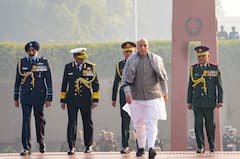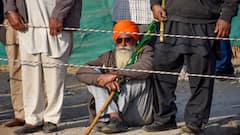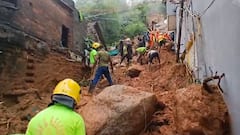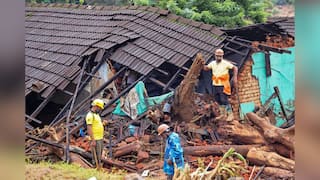Heatwave To Scorch North India On LS Phase 7 Voting Day, Conditions To Abate Thereafter In 2-3 Days
Heatwave News: Parts of Punjab, Haryana-Chandigarh-Delhi, Odisha, and other regions will continue to experience heatwave conditions on June 1-2. The IMD predicts a gradual decrease in heatwave conditions across Northwest, Central, and East India over the next 2-3 days.

Heatwave News: The Indian Meteorological Department (IMD) has predicted a gradual abatement of the prevailing heatwave conditions in Northwest, Central, and East India over the next 2 to 3 days, according to a statement on Friday. The heatwave has significantly affected regions such as Rajasthan, Punjab, Haryana, Chandigarh-Delhi, and Uttar Pradesh, with temperatures soaring as high as 48.3°C in Sri Ganganagar, Rajasthan. The IMD also issued warnings for isolated heavy to very heavy rainfall in Northeast India over the next 4-5 days.
The IMD has forecasted that the heatwave conditions will likely persist over parts of Punjab, Haryana-Chandigarh-Delhi, Uttarakhand, East Uttar Pradesh, Madhya Pradesh, Vidarbha, Chhattisgarh, Bihar, Jharkhand and isolated places over Odisha on June 1, 2024. The final phase of the Lok Sabha elections 2024 is set to take place on Sunday as voters will brave intense heat to queue up and exercise their franchise.
Heatwave conditions very likely in few parts of Punjab, Haryana-Chandigarh-Delhi, isolated pockets Uttarakhand, East Uttar Pradesh, Madhya Pradesh, Vidarbha, Chhattisgarh, Bihar, Jharkhand and Odisha on 01st June, 2024. pic.twitter.com/OfuO8AIDQf
— India Meteorological Department (@Indiametdept) May 31, 2024
Additionally, the heatwave is expected to continue in some areas of Coastal Andhra Pradesh, and Yanam until June 1, with warm night conditions persisting in Odisha and Madhya Pradesh.
Isolated pockets of Punjab, Haryana-Chandigarh-Delhi and Odisha will continue to experience heatwave on June 2 also, as per another IMD post.
Heatwave conditions likely in isolated pockets of Punjab, Haryana-Chandigarh-Delhi and Odisha on 02nd June, 2024.#heatwave #weatherupdate #heatwavealert@moesgoi @ndmaindia @DDNational @airnewsalerts@RailMinIndia @DDNewslive @NHAI_Official pic.twitter.com/hFpqKPxIoy
— India Meteorological Department (@Indiametdept) May 31, 2024
Many parts of India, including Himachal Pradesh, Uttarakhand, Vidarbha, and Chhattisgarh, have been experiencing heatwave conditions. The IMD noted that the highest temperature recorded yesterday was 48.3°C in Sri Ganganagar, West Rajasthan. Meanwhile, isolated pockets of Rajasthan, Uttar Pradesh, Bihar, Jharkhand, Odisha, and Madhya Pradesh observed warm night conditions.
ALSO READ | Lok Sabha Polls Phase 7: Final Phase Of World’s Largest Polling Marathon Set To Conclude With Modi In Fray
Delhi Sees Second-Highest Temperature This Season
The national capital has been particularly affected by the heatwave, with temperatures soaring to 45.8°C, six degrees above normal. This marks the fifth consecutive day of extreme heat in Delhi. The IMD recorded this as the second-highest temperature at the Safdarjung Observatory this summer, with a high of 46.8°C noted earlier in the month.
Delhi has experienced minimal rainfall in May, recording only two rainy days—the lowest in a decade. A 'yellow alert' has been issued for Saturday, forecasting cloudy skies with possible thunderstorms, dust storms, light showers, and gusty winds up to 40 kmph.
Regarding the heatwave, the IMD has issued an orange alert for several regions, warning of high health risks, particularly for vulnerable individuals. Residents are advised to stay hydrated, avoid sun exposure, and wear lightweight, loose clothing. A yellow alert indicates moderate health concerns, suggesting similar precautions.
ALSO READ | Heatwave Claims Lives Of 25 Poll Officials Amid 40 Heat-Related Deaths Ahead Of Phase 7 LS Voting
Scorching Heatwave Persists In Rajasthan
Rajasthan continues to endure a relentless heatwave, with temperatures remaining extremely high despite a slight decrease. On Friday, Karauli recorded a peak temperature of 47.6 degrees Celsius, while the state capital, Jaipur, experienced a high of 45 degrees Celsius.
According to the local Meteorological Department, other regions in Rajasthan also faced severe heat. Ganganagar recorded a maximum temperature of 47.3 degrees Celsius, followed by 46.7 degrees in Sangaria, 46.6 degrees in Banasthali (Tonk), 46.5 degrees in Alwar, 46.4 degrees in Dholpur, 46.2 degrees in Churu, and 46.1 degrees in Fatehpur (Sikar).
While there was a slight drop of one to two degrees Celsius in maximum temperatures compared to Thursday, the temperatures still ranged from one to five degrees Celsius above normal. This indicates that the heatwave remains intense across most parts of the state.
Looking ahead, light rains accompanied by strong winds are predicted in some areas of Rajasthan over the next few days, which may provide temporary relief from the extreme heat.
Southwest Monsoon To Further Advance Towards Kerala, Karnataka, Tamil Nadu In Next 2-3 Days
Simultaneously, the IMD reported heavy to very heavy rainfall with extremely heavy falls in isolated places over Meghalaya. Heavy rainfall was also recorded in Sub-Himalayan West Bengal & Sikkim, Assam, Bihar, Gangetic West Bengal, Kerala, and Arunachal Pradesh. A hailstorm was observed in isolated places over Jammu-Kashmir and Uttarakhand, as per IMD's statement.
The IMD highlighted the advance of the Southwest Monsoon, which has now reached the northeast Bay of Bengal, parts of northwest Bay of Bengal, Tripura, Meghalaya, Assam, and most parts of Sub-Himalayan West Bengal & Sikkim. The monsoon is expected to further advance into central and southern Arabian Sea, Lakshadweep, Kerala, Karnataka, Tamil Nadu, and Southwest Bay of Bengal in the next 2-3 days.
Heavy rainfall in Assam, Meghalaya, and Arunachal Pradesh is expected to cause localised flooding, waterlogging, reduced visibility, and disruptions in major cities. Residents are advised to check traffic conditions before travel, avoid waterlogged areas, and stay in safe structures.
In regions expecting thunderstorms, lightning, and gusty winds, the IMD advises residents to stay indoors, avoid sheltering under trees, unplug electrical appliances, and stay away from water bodies and metal objects.
Trending News
Top Headlines






































